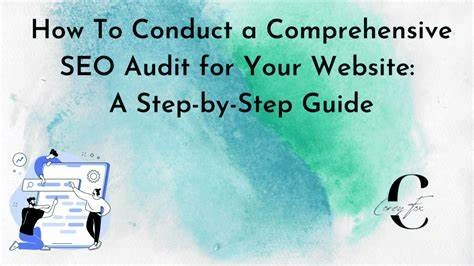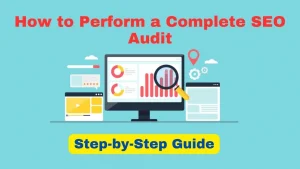How to Perform a Comprehensive SEO Audit
SEO (Search Engine Optimization) is the cornerstone of online visibility in today’s digital world. However, achieving and maintaining a strong online presence requires more than just optimizing keywords or creating content. A comprehensive SEO audit is your roadmap to identifying strengths, uncovering weaknesses, and implementing strategies that make your website a magnet for organic traffic.
Here’s a step-by-step guide to performing a detailed SEO audit that’s both actionable and effective:
1. Understand the Purpose of the Audit
You should set clear objectives for your audit before you begin. Are you trying to improve organic traffic, fix ranking drops, or analyze competitor performance? Knowing your purpose will help you focus on relevant areas and maximize the audit’s impact.
2. Check Your Website’s Technical Health
By using technical SEO techniques, you can ensure that your website will be crawled and indexed by search engines efficiently. Use tools like Google Search Console, Screaming Frog, or Ahrefs to analyze your site’s technical setup.
Key areas to inspect:
- Crawlability: Ensure that search engines can easily access all important pages. Check your robots.txt file for broken links, orphan pages, and blocked resources.
- Indexability: Review your sitemap and ensure it lists all relevant pages. Remove unnecessary or outdated URLs.
- Site Speed: A slow website can hurt rankings. Use Google Page Speed Insights or Metrix to measure load times and optimize images, CSS, and JavaScript.
- Mobile-Friendliness: With Google’s mobile-first indexing, ensure your website is responsive and user-friendly on all devices.
- HTTPS Protocol: Secure websites rank better. Ensure your site uses HTTPS and has no mixed-content errors.
3. Analyze On-Page SEO Elements
You’re on-page elements are crucial for both user experience and search engine rankings. Focus on the following:
Key checks:
- Meta Tags: Review title tags and meta descriptions for all pages. Ensure they’re unique, keyword-rich, and within the character limits.
- Headings (H1, H2, etc.): Use headings to structure content logically. Ensure each page has one H1 and relevant subheadings.
- Content Quality: Check for thin, duplicate, or outdated content. Create in-depth, engaging, and keyword-optimized articles that provide value to users.
- Keyword Optimization: Ensure your target keywords are naturally integrated into the content, headings, and image alt texts.
- Internal Linking: Links between internal pages enhance navigation and distribute link equity. Fix broken or irrelevant links.
4. Evaluate Content Performance
High-quality content is the backbone of SEO. Audit your content’s performance to ensure it meets user intent and ranks well.
Steps to follow:
- Identify Top-Performing Pages: Use tools like Google Analytics to see which pages drive the most traffic. Analyze what’s working and replicate the strategy for underperforming pages.
- Update Old Content: Refresh outdated articles with current information, new data, and better visuals.
- Content Gap Analysis: Research competitors to identify topics you’ve missed and create content around those gaps.
- Optimize for Featured Snippets: Format content for snippet opportunities, such as bullet points, tables, or direct answers.
5. Examine Backlink Profile
Backlinks remain a key ranking factor, but quality trumps quantity. Analyze your backlink profile to ensure it’s helping, not hurting, your SEO.
What to look for:
- Link Quality: Focus on links from authoritative and relevant websites. Disavow toxic or spammy backlinks.
- Anchor Text Diversity: Ensure your anchor texts are natural and not over-optimized.
- Competitor Backlinks: Study where your competitors’ backlinks come from and explore similar opportunities.
- Broken Backlinks: Reclaim broken links pointing to your site by contacting the linking domains with updated URLs.
6. Review Core Web Vitals
Users experience metrics such as loading time, interactivity, and visual stability are emphasized in Core Web Vitals. Check your website’s performance on:
- Largest Contentful Paint (LCP): Measures loading performance. Aim for under 2.5 seconds.
- First Input Delay (FID): Measures interactivity. Ensure it’s less than 100 milliseconds.
- Cumulative Layout Shift (CLS): Measures visual stability. Keep it under 0.1.
7. Audit Local SEO (If Applicable)
Local businesses need to optimize for local SEO. Focus on:
- Google My Business: Ensure your profile is complete and up to date with accurate contact information and reviews.
- NAP Consistency: Make sure all listings have consistent Name, Address, and Phone Numbers.
- Local Citations: Build citations on reputable directories like Yelp and Bing Places.
- Reviews and Ratings: It is important to encourage satisfied customers to leave positive reviews.
8. Monitor Competitor Performance
Analyze what your competitors are doing right. Tools like SEMrush and Ahrefs can help you:
- Identify their top-performing keywords.
- Study their backlink strategies.
- Benchmark your performance against theirs.
9. Create a Prioritized Action Plan
An audit is only valuable if it leads to actionable improvements. Develop a clear action plan based on your findings:
- High Priority: Critical issues like crawl errors, broken links, or missing HTTPS.
- Medium Priority: Content updates, internal linking, or keyword optimization.
- Low Priority: Cosmetic changes or minor speed optimizations.
10. Track Progress and Iterate
SEO is not a one-time task. After implementing changes, monitor your progress regularly using tools like Google Analytics, Search Console, and third-party SEO tools. Maintain a competitive edge by iterating improvements.
A comprehensive SEO audit isn’t just about finding problems it’s about uncovering opportunities to grow and refine your online presence. By following these steps, you’ll set your website on a path to improved rankings, better user experience, and long-term success.




